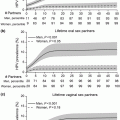© Springer International Publishing Switzerland 2017
Wojciech Golusiński, C. René Leemans and Andreas Dietz (eds.)HPV Infection in Head and Neck CancerRecent Results in Cancer Research20610.1007/978-3-319-43580-0_20Update on De-intensification and Intensification Studies in HPV
(1)
Chair of Head and Neck Surgery, School of Cancer Sciences, University of Birmingham, Birmingham, England, UK
(2)
Institute of Head and Neck Studies and Education, University of Birmingham, Birmingham, England, UK
Abstract
In this chapter, we discuss de-esclation of treatment for patients with HPV-positive disease. We discuss the rationale for de-escalation (why de-escalate?), patient selection criteria (who to de-esclate?) and what the treatment options for de-esclation are and the studies that are currently being run in those areas (how to de-escalate?). We stress the importance of clinicians NOT changing the management of oropharyngeal cancer patients outside clinical trials, and encourage them to recruit to the ongoing studies.
Keywords
De-escalation of HPVEpidemiology of HPVHead and neck cancerMolecular biology of HPVTesting of HPVTreatment of HPVAs we have seen in previous chapters, the seminal paper by Ang et al. (2010) demonstrated that there were several prognostic groups within oropharyngeal cancer. This prognostic classifier has been validated in other cohorts. There are other prognostic classifiers that have also been developed that show similar findings with some variations. However, they consistently demonstrate that HPV-positive disease has better outcomes than HPV-negative disease (Huang et al. 2015). In addition, it would appear that HPV positivity maintains its prognostic effect regardless of the type of treatment (Haughey and Sinha 2012). As a consequence of the improved prognosis of HPV-positive patients, many clinicians and researchers around the world have considered and are considering de-intensification of treatment for HPV-positive disease. There are several studies that have been completed or are being currently run for this indication. In this article, we will discuss the following aspects:
Why should we de-intensify treatment?
Who should we de-intensify treatment for?
How should we de-intensify treatment?
1 Why Should We De-intensify Treatment?
As can be seen from the prognostic classifiers, the low-risk HPV-positive patients have excellent survival. These patients tend to be younger than the traditional head and neck cancer patient. This means that as they have a higher chance of cure, they will live longer with the substantial effects of treatment. Indeed, we know that chemoradiotherapy results in considerable early and late toxicities (Trotti et al. 2007), and that late toxicity is cumulative (Machtay et al. 2008). Therefore, it would seem reasonable to try to reduce the toxicity profile in these patients who have excellent long-term survival to improve their overall quality of life and reduce the long-term burden of treatment.
In addition, it would appear that patients are supportive of de-intensification of chemoradiotherapy regimens for HPV-positive low-risk disease. However, the majority of them are supportive only if there is little or no chance of detriment to their overall survival. Furthermore, it should be noted that over a quarter do not want de-intensification. In addition, the majority of those who are in favour of de-intensification would reduce the chemotherapy part of the treatment, and only 20 % would wish to reduce radiotherapy (Brotherston et al. 2013).
2 Who Should We De-intensify Treatment for?
The overall principle guiding treatment is primum non nocere—first do no harm. These patients have excellent survival, and are in the main, cured of their disease. Many studies, including the one quoted above by Brotherstone, show that patients’ most important aim for treatment is cure followed by prolonged survival. Therefore, in all our discussions on de-intensification the maintenance of the very high cure rates for patients should be paramount.
When considering what the causes of treatment failure are in patients with high-risk disease, one identifies that they most often fail locoregionally. This was apparent in the RTOG 0129 study by Ang et al. (2010). In that study, distant metastatic failure did not differ significantly between HPV-positive and HPV-negative disease. Other studies e.g. by O’Sullivan et al. (2013) have shown that HPV-positive disease and HPV-negative disease have similar distant control rates. Work by the same group in Toronto has shown that the risk of distant metastasis in HPV-positive patients is highest in those who were treated with radiotherapy alone [with N2b disease and who are heavy smokers, or who have N2c or N3 disease]. Distant metastasis is also high in patients who have HPV-positive T4 disease. Therefore, we should be aware of de-intensifying treatment, especially by removing chemotherapy, in these patients who in the main constitute the intermediate HPV-positive risk category.
3 What Are the Options for De-intensification?
There are several options for de-intensification: using less toxic chemotherapy regimens, removing chemotherapy, reducing the radiotherapy dose, and incorporating surgery and reducing post-operative chemoradiotherapy regimens. Fortunately, there has been a strong emphasis on ensuring that these de-intensification options are tested within clinical trials, and that clinicians do NOT change the management of HPV-positive patients outside of clinical trials. In this next section, we will discuss the different options for de-intensification and the ongoing trials within that area.
Stay updated, free articles. Join our Telegram channel

Full access? Get Clinical Tree






